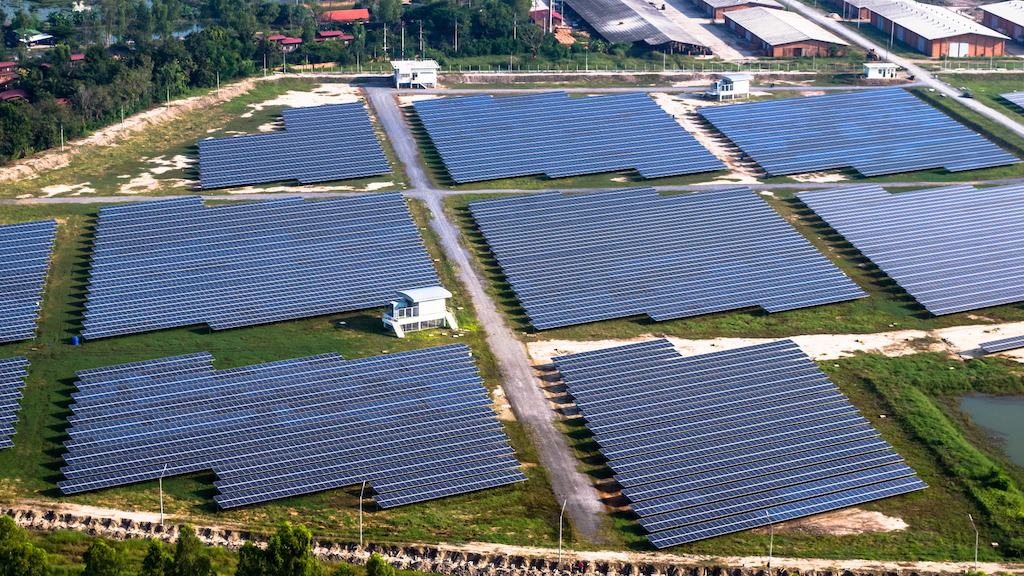Image source: Canva.com
Solar farms are expansive ground-mounted solar installations that cover extensive areas of open land.
These installations are characterized by their immense scale, with capacities often reaching into the megawatts (equivalent to 1,000 kilowatts). If you reside on a rural property or possess ample acreage that you wish to utilize for generating renewable energy through solar panels, a solar farm could be a fitting choice for you.
What Exactly is a Solar Farm?
A solar farm refers to a large-scale, ground-mounted solar installation that utilizes photovoltaic (PV) panels or other solar energy collection methods, such as concentrating solar systems, to harness the sun’s energy.
These solar farms, also referred to as ‘solar parks,’ ‘solar plants,’ or ‘solar power stations,’ function akin to traditional power plants, generating electricity for consumers similar to fossil-fueled counterparts that have been in operation for decades.
Distinguishing Features
Scale
Solar farms differ from rooftop solar systems and commercial solar power setups due to their large-scale nature, capitalizing on economies of scale by procuring equipment in bulk to reduce costs.
Ideal location
Situated in optimal locations, solar farms are often free from shading issues caused by trees, ensuring maximum solar exposure.
Decentralized layout
Typically featuring ground-mounted solar panels spread across expansive areas, solar farms are decentralized in their layout.
Grid connectivity
Most solar farms are integrated into the electric grid, contributing to the utility’s energy supply.
Furthermore, various types of large-scale solar projects exist, including community solar farms and utility-scale solar farms, catering to diverse energy needs and preferences.
Varieties of Solar Farms: Utility vs. Community
The primary contrast between utility-scale solar farms and community solar farms lies in their scale: utility-scale projects typically dwarf community solar installations.
Utility-scale solar farms boast capacities ranging from 1 MW to a whopping 2,000 MW. Conversely, community solar farms are relatively smaller, typically under 5 MW, with some even falling below the 100 kW mark.
Another distinguishing factor is their target audience:
Community solar farm initiatives cater to subscribers or members who have invested in a share of their energy output. Conversely, utility solar farms supply electricity to the utility company, which then distributes it among all its customers as part of its overall energy portfolio.
In terms of technology, both types of installations often utilize 500-watt solar panels, renowned for their enhanced power output compared to panels commonly found in residential setups.
What is the Cost of Building a Solar Farm?
Solar farm installation expenses typically range $0.98 per watt. For instance, constructing a 1-megawatt (MW) solar farm could incur costs nearly $980,000.
These estimates are derived from the SEIA’s average national cost data as of Q2 2024, assuming the availability of land for the solar farm’s construction.
Compared to rooftop solar systems, solar farms offer significantly lower installation and operational costs.
The affordability of solar farms has led utilities to increasingly incorporate them into their new power generation capacities. Not only is solar among the most cost-effective forms of renewable energy, but it has also become competitive with fossil fuel-based energy sources.
Factors to Consider When Starting a Solar Farm
Before launching a solar farm, several key factors should be evaluated:
- Upfront Costs: Both commercial and residential solar projects involve significant initial investment. Costs depend on land size and the number of panels installed.
- Time Frame: Construction and energy collection for solar farms can span several months, and obtaining necessary permits and approvals might take years.
- Electrical Infrastructure: Solar energy is transmitted through lines to substations for conversion and distribution. Limited capacity at transmission lines and substations might require you to join an interconnection queue. If no transmission lines are nearby, you’ll need to coordinate with your local utility to install one, which is not guaranteed.
- Land Requirements: Consider factors like acreage, solar irradiance, slope, and zoning. Adequate land is needed not only for the panels but also for equipment and maintenance. Ideally, the land should be flat to accommodate solar panel installation.
- Calculations: To meet energy demands, calculate the required kilowatt-hours and determine the number of panels needed for your array.
- Permits: Ensure you acquire all necessary licenses and permits, such as those for grid connection. Regulations vary by location, so research local requirements thoroughly.
- Insurance: Obtain appropriate insurance policies, including liability and equipment coverage, to protect against potential financial losses.
- Maintenance: While modern solar panels require minimal maintenance, you may need to handle upkeep and repairs, depending on your agreement with the installer.
Process for Starting a Solar Farm
- Research: Begin with comprehensive research into the requirements for starting a solar farm. Investigate local permits, installation costs, available solar installers, and existing electrical infrastructure on your property.
- Develop a Business Plan: As establishing a solar farm involves creating a new business, prepare a detailed business plan and ensure you secure the necessary legal permits, which vary by location.
- Construction: After obtaining the necessary approvals and permits, proceed with the construction phase by collaborating with a solar installer to set up the solar panels.
While many landowners choose to lease their land to solar companies, property owners also have the option to install solar panels themselves and sell the generated electricity to the utility company. It is crucial to approach the establishment of your own solar farm with careful planning and thorough due diligence. Both leasing and owning a solar farm offer opportunities for property owners to earn income and support clean energy initiatives.





